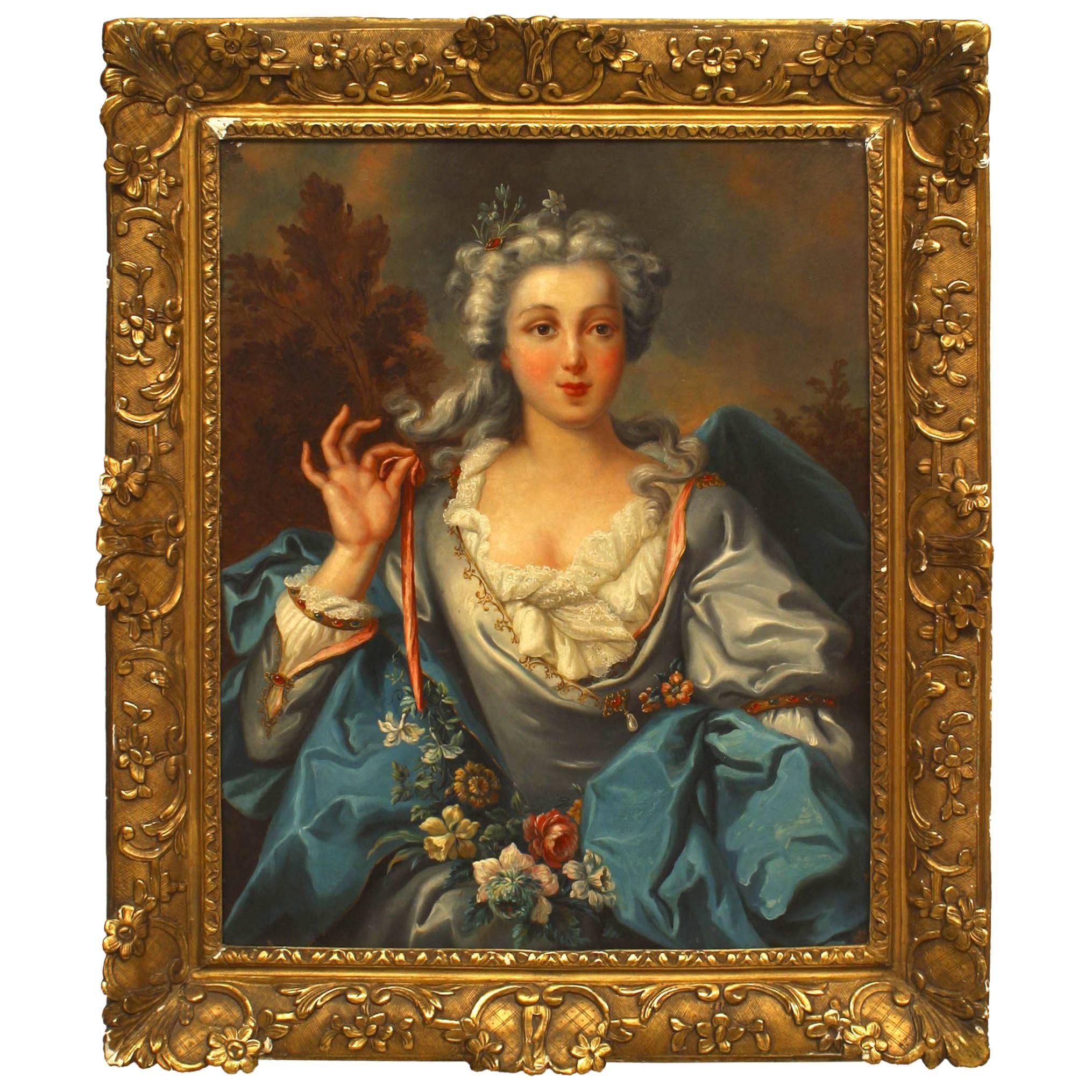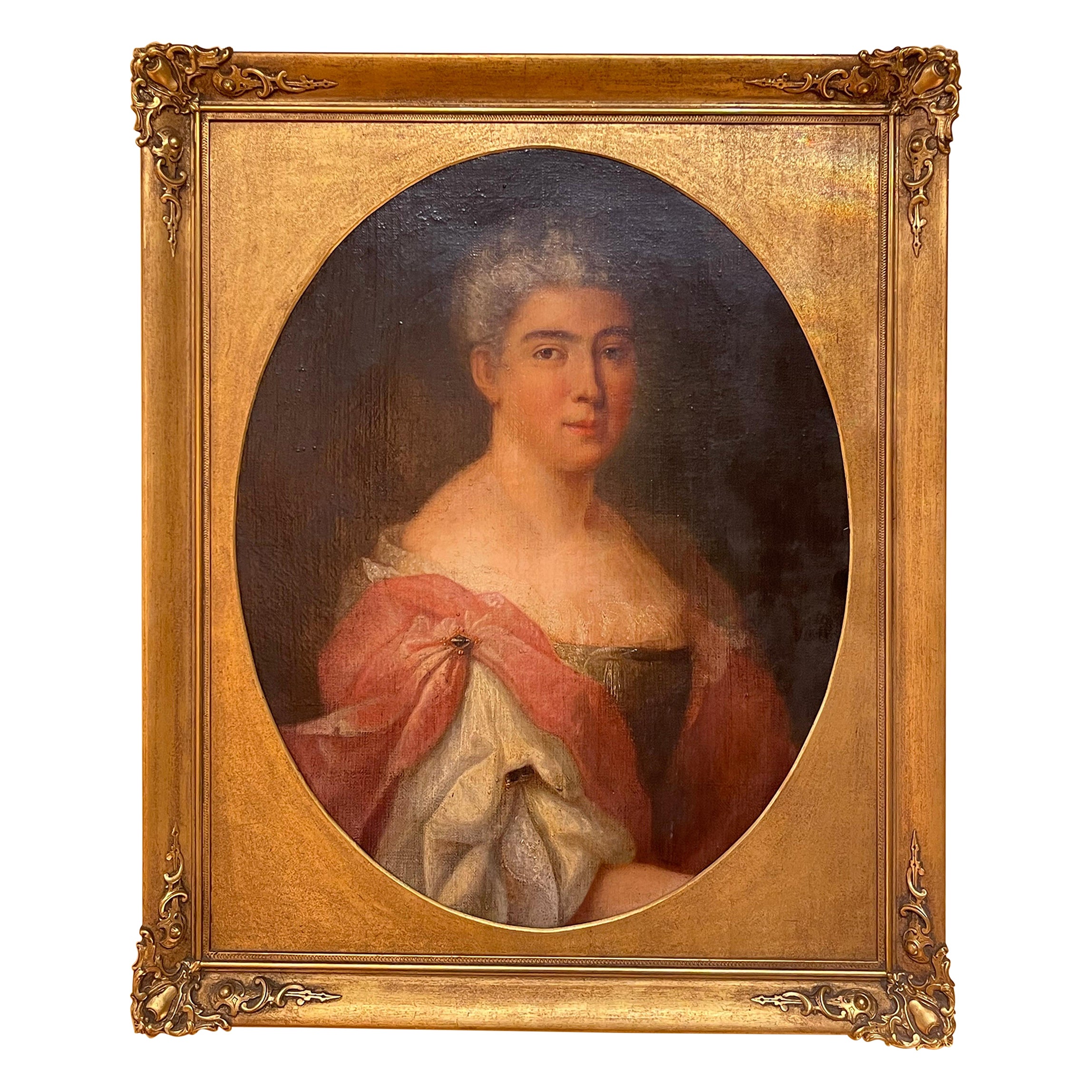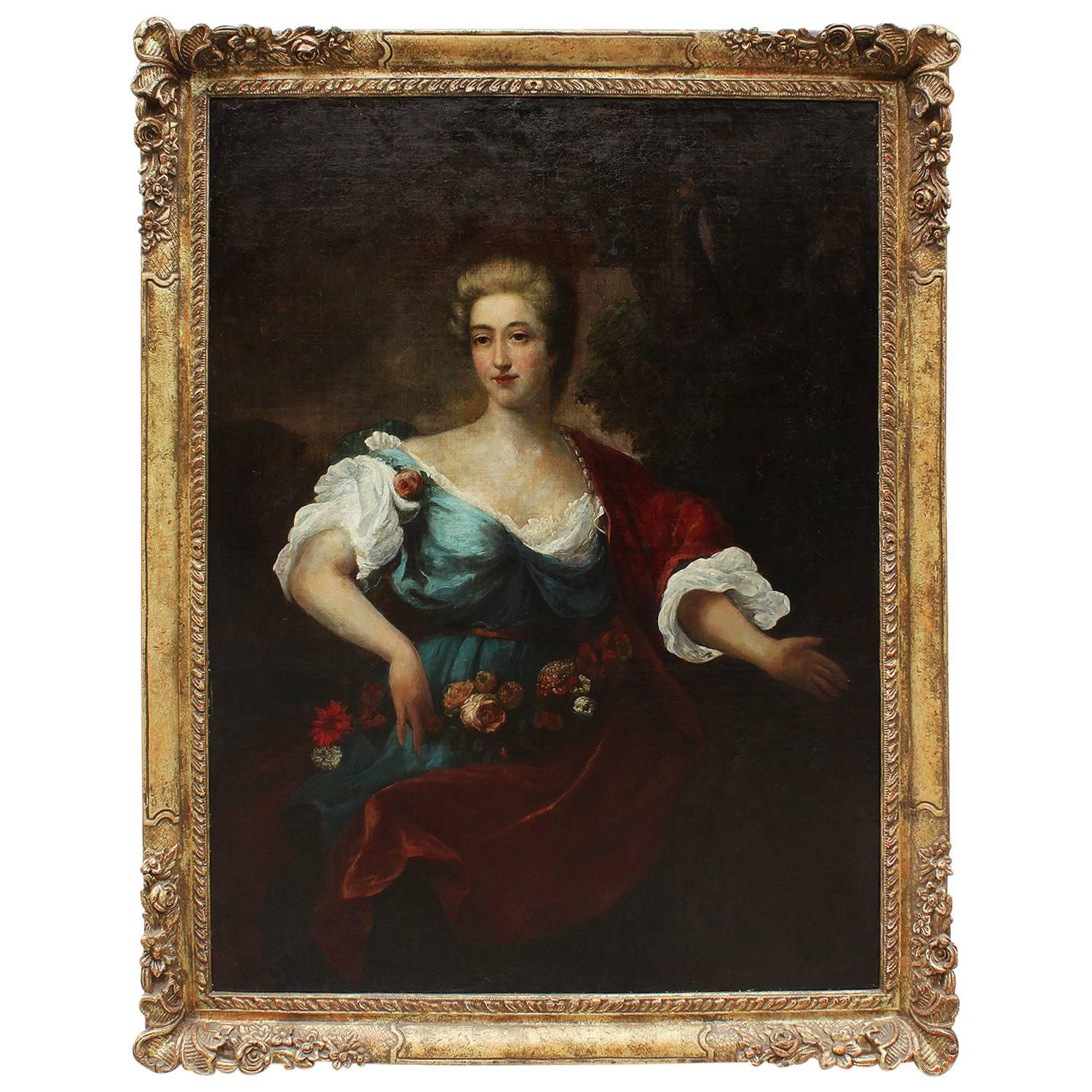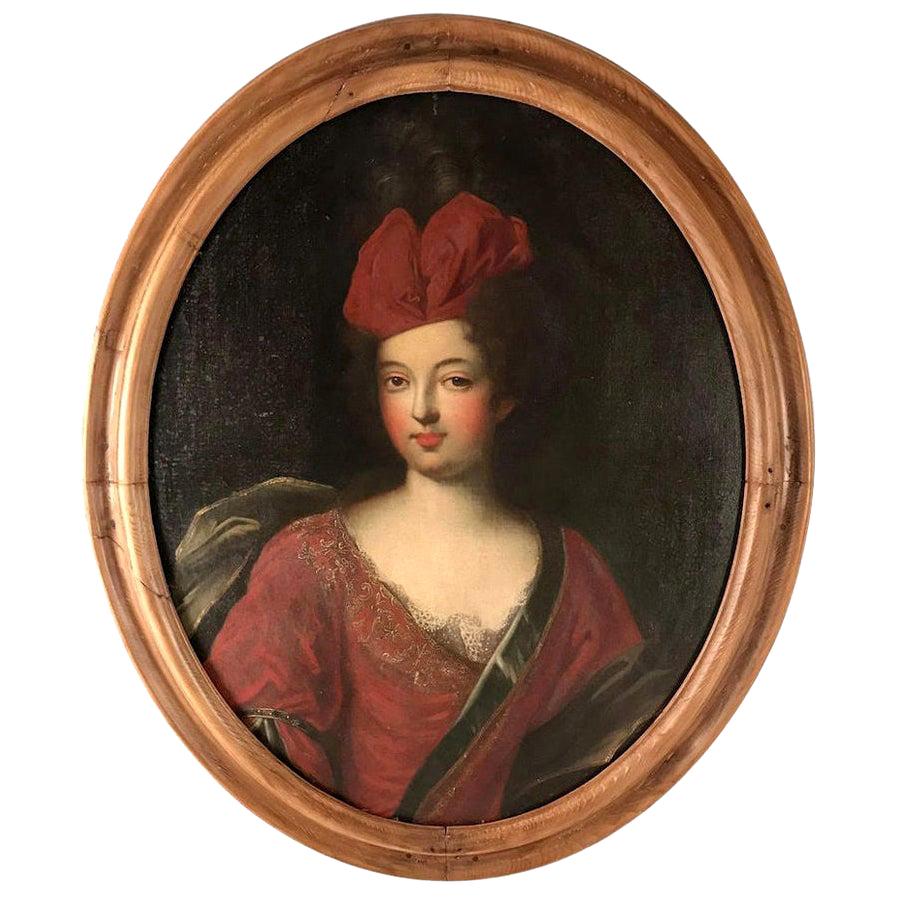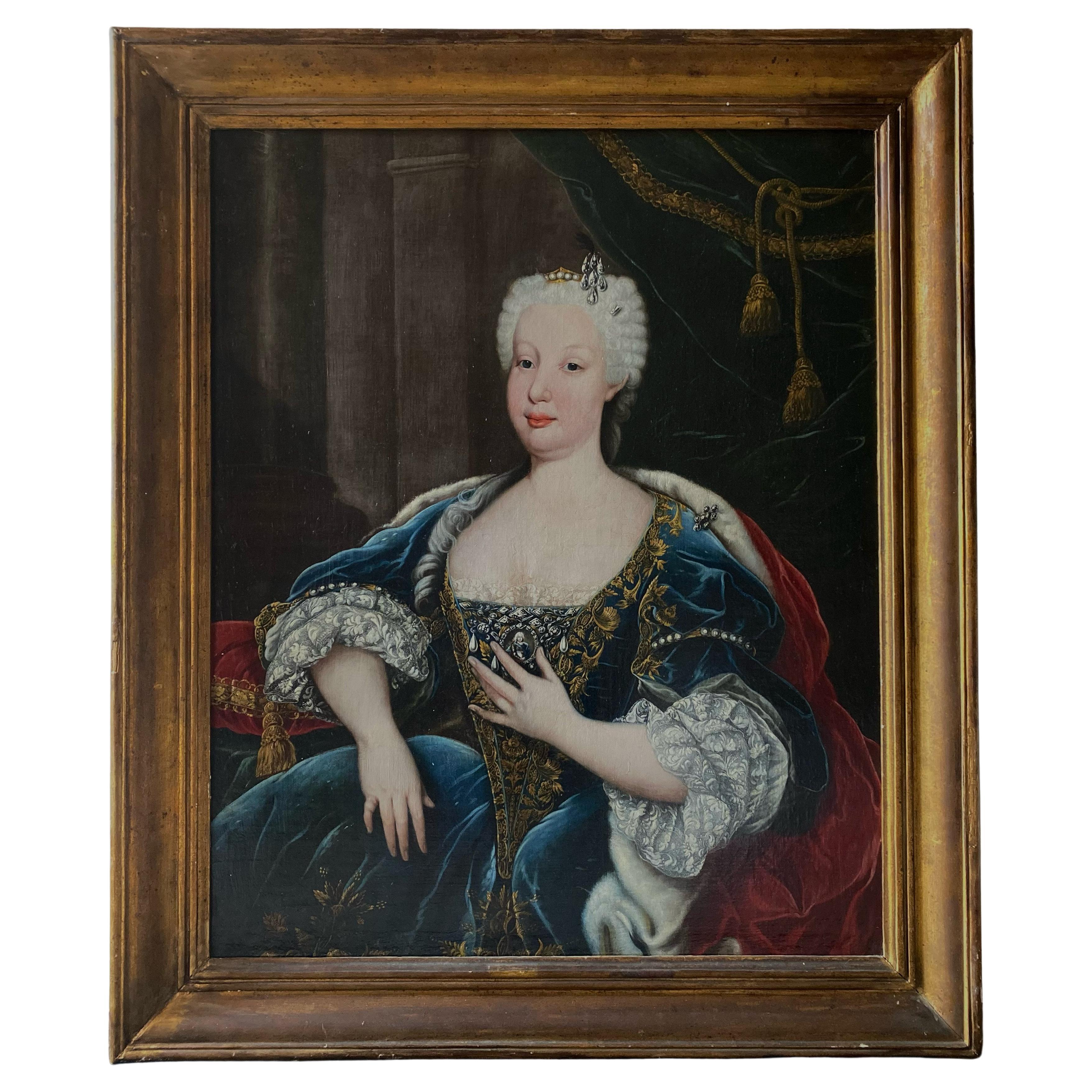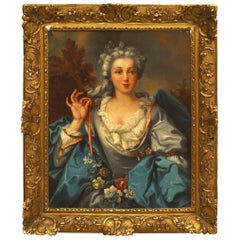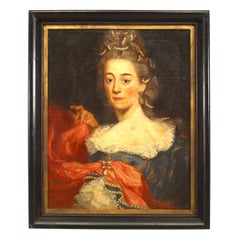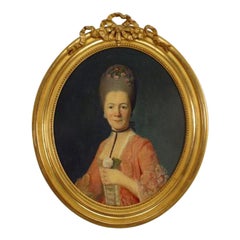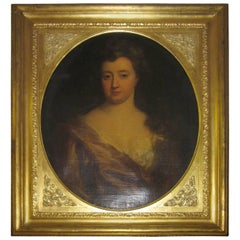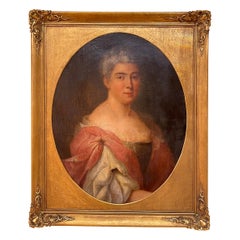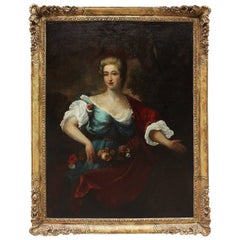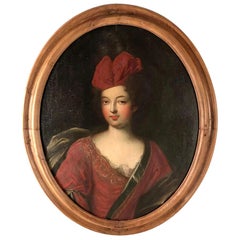Items Similar to French Louis XVI Crowned Lady Portrait
Want more images or videos?
Request additional images or videos from the seller
1 of 2
French Louis XVI Crowned Lady Portrait
$11,500
£8,725.94
€9,977.33
CA$16,062.38
A$17,859.18
CHF 9,325.08
MX$217,389.74
NOK 118,983.96
SEK 111,482.28
DKK 74,462.63
Shipping
Retrieving quote...The 1stDibs Promise:
Authenticity Guarantee,
Money-Back Guarantee,
24-Hour Cancellation
About the Item
French Louis XVI style (18th Cent) gilt framed oval oil painting portrait of lady wearing crown
- Dimensions:Height: 48 in (121.92 cm)Width: 42 in (106.68 cm)
- Style:Louis XVI (Of the Period)
- Materials and Techniques:
- Place of Origin:
- Period:
- Date of Manufacture:Circa 1750
- Condition:Wear consistent with age and use.
- Seller Location:Queens, NY
- Reference Number:Seller: 032472A1stDibs: LU977940753622
About the Seller
4.9
Recognized Seller
These prestigious sellers are industry leaders and represent the highest echelon for item quality and design.
Platinum Seller
Premium sellers with a 4.7+ rating and 24-hour response times
Established in 1939
1stDibs seller since 2013
981 sales on 1stDibs
Typical response time: <1 hour
- ShippingRetrieving quote...Shipping from: Long Island City, NY
- Return Policy
Authenticity Guarantee
In the unlikely event there’s an issue with an item’s authenticity, contact us within 1 year for a full refund. DetailsMoney-Back Guarantee
If your item is not as described, is damaged in transit, or does not arrive, contact us within 7 days for a full refund. Details24-Hour Cancellation
You have a 24-hour grace period in which to reconsider your purchase, with no questions asked.Vetted Professional Sellers
Our world-class sellers must adhere to strict standards for service and quality, maintaining the integrity of our listings.Price-Match Guarantee
If you find that a seller listed the same item for a lower price elsewhere, we’ll match it.Trusted Global Delivery
Our best-in-class carrier network provides specialized shipping options worldwide, including custom delivery.More From This Seller
View AllFrench Louis XVI Young Woman Portrait
Located in Queens, NY
French Louis XVI (18/19th Cent) portrait oil painting of young woman wearing a blue dress holding a pink ribbon with flowers in her hair in a gold carved frame (style of NATTIER)
Category
Antique Late 18th Century French Louis XVI Paintings
Materials
Gold
French Louis XVI Lady in Blue Portrait
Located in Queens, NY
French Louis XVI (18th Cent) oil painting portrait of a lady in a blue dress with lace trim & flowers in her hair holding a book seated next to a large urn in a stripped carved frame...
Category
Antique 18th Century French Louis XVI Paintings
American Victorian Lady Portrait
Located in Queens, NY
American Victorian ebonized framed oil portrait, painting of 19th Century lady in blue and red dress.
Category
Antique 19th Century American Victorian Paintings
Materials
Paint
French Woman Portrait
Located in Queens, NY
Copy of portrait painting of a French woman in gown holding rose, in gold oval frame- (Companion to TR2005)
Category
Late 20th Century French Victorian Paintings
Materials
Paint
$4,900
Russian Portrait of Royal Marija Federova
Located in Queens, NY
Copy of a classical portrait of Russian royal Marija Federova showing woman in formal gown at desk
Category
Late 20th Century American Baltic Paintings
Materials
Paint
18th Century French Giltwood Framed Oil Painting Portrait of a Woman
Located in Queens, NY
French (18th century) oil painting portrait of a woman holding grapes sitting next to a dog in a rectangular carved giltwood frame.
Category
Antique Mid-18th Century French Empire Paintings
Materials
Giltwood, Paint
You May Also Like
18th century Portrait of Lady Oil on Canvas in Giltwood Frame
Located in Savannah, GA
English oil on canvas portrait dating from the late 1700s painted in the manor of Joshua Reynolds. We believe the giltwood frame could be the original as it is right for the period. ...
Category
Antique 1790s English Rococo Paintings
Materials
Canvas, Wood
$3,900 Sale Price
40% Off
Antique Portrait / Oil Painting of a Noblewoman, France 18th Century
Located in Berlin, DE
Antique portrait / oil painting of a noblewoman, France 18th Century
Painting painted oil on canvas, oval stretcher. Portrait of an eagle lady, probably ...
Category
Antique 18th Century French Paintings
Materials
Canvas
French 18th-19th Century Oil on Canvas Portrait of Lady, after Jean-Marc Nattier
By Jean-Marc Nattier
Located in Los Angeles, CA
A very fine French 18th-19th century oil on canvas portrait of a posing lady with flowers, after Jean-Marc Nattier (1685-1766) within an ornate gilt wood carved frame, circa 1800.
...
Category
Antique Early 19th Century French Louis XV Paintings
Materials
Canvas, Giltwood
$11,960 Sale Price
20% Off
Late 17th Century Oil Portrait of a Lady
Located in Lymington, GB
An oil on canvas portrait of a young French courtier, circa 1690.
This evocative antique French-school picture has been attributed to the portrait painter Jean-François de Troy (1679-1752).
De Troy was famous as a portrait painter of fashionable society women.
This is a very attractive late-17th century painting surviving in its original frame and stretcher. The canvas appears to be untouched.
References:
'Jean François de Troy, The Alarm, or the Gouvernante Fidèle', at the Victoria and Albert Museum, London.
'Jean François de Troy, Paris 1679 - Rome 1752', at the Thyssen-Bornemisza Museum.
Laurie G. Winters, Troy, de, Grove Art Online, Oxford Art Online, Oxford University Press, 6 May 2016.
Everett Fahy & Jayne Wrightsman...
Category
Antique 17th Century French Paintings
Materials
Canvas
Portrait of D. Maria Bárbara De Bragança, Circle of Louis-Michel Van Loo
By H. van Loon
Located in Lisboa, PT
PORTRAIT OF D. MARIA BÁRBARA DE BRAGANÇA (1711-1758), QUEEN OF SPAIN
Circle of Louis-Michel van Loo (1707-1771)
Oil on canvas
Her Royal Highness, the Infanta Maria Barbara of Braganza (1711-1758) was the first-born child of King John V of Portugal (1689-1750) and his queen consort Maria Anna of Austria (1683-1754). Born in December 1711, she had the Convent Palace of Mafra built in her honour following a vow made by her royal father. Her status as Princess of Brazil, inherent to 18th century Portuguese presumptive heirs, would however be superseded once the queen gave birth to two male princes, D. Pedro (1712-1714) and D. José (1714-1777), preventing her from ascending to the throne.
Daughter of one of the most illustrious monarchs of his time, Maria Barbara was carefully educated to become a fond admirer of the arts, and of music in particular, having had the Italian composer Domenico Scarlatti (1685-1757) as her music teacher.
On the 10th January 1723 the young princess was betrothed to the Infante Ferdinand of Spain (1713-1759), eldest son of King Philip V (1683-1746). Six years later, on the 19th January, she entered her new country in a carefully choreographed ceremony that became known to history as the “Exchange of the Princesses”. This unique event took place on a specially built Bridge-Palace, a wooden, luxuriously decorated structure that included various modules and rooms, on both banks of the river Caia, the natural border between the town of Elvas in Portugal and of Badajoz in Spain. Simultaneously, on the same day that the Portuguese Infanta crossed the border to marry the Spanish Crown Prince, her new sister in law, the Infanta Mariana Victoria of Bourbon (1718-1781), her husband’s sister, crossed the same bridge in the opposite direction to marry Prince D. José, the Portuguese heir to the throne.
Once married, Maria Barbara would spend 17 years as Princess of Asturias, only becoming Queen of Spain at her husband’s accession following the death of Philip V in 1746. She is portrayed in the 1743 painting by Louis-Michel van Loo (1707-1771) now in the Prado Museum, in which Philip V had himself represented with all his close family.
The new Queen would take an important role at court eventually becoming the liaison between her husband and the King of Portugal, particularly throughout the negotiations for the Treaty of Madrid (1746-1750). Maintaining her interest in music, she patronized the Italian castrato singer Farinelli (1705-1782) while remaining close to her old master Scarlatti, having herself composed some sonatas for a large orchestra. She would also commission and fund the building of the Royal Salesians Monastery complex in central Madrid, where both her and Ferdinand VI are buried.
The portrait we are presenting for sale shows the Queen in half-length, turning left at three quarters. She is wearing a blue low-cut dress embroidered with flowers and foliage, over a lace cuffed white blouse, and an ermine cloak pined on the left-hand side by a diamond broach. The powdered hair style is held sideways by a seven diamond and black plume headdress and topped by a small gold and pearl crown. The right arm rests on a cushion while the left hand, at chest height, holds a miniature male portrait.
The Infanta’s features are analogous to the 1725 portrait by the painter Domenico Duprà (1689-1770), also in the Prado Museum collection. Further similarities can be found in another portrait by Louis-Michel van Loo, in which a seven diamond and black plume headdress is also present. In this work, the cushion supporting Maria Barbara’s right arm has also some obvious similarities to our painting. The same diamond headdress reappears in Van Loo’s above-mentioned portrait of Philip V’s family dated from 1743.
It is nevertheless in Lisbon’s Ajuda National Palace that it is possible to find an almost identical depiction of the Infanta holding a miniature portrait of her husband. In it, the future Ferdinand VI is portrayed facing right at three quarters and wearing a curly wig, suit of armour, the golden fleece insignia and a blue band, in a composition that closely resembles an 18th century Spanish school painting that appeared in the art market in January 2016.
Another detail common to various portraits of the Portuguese Infanta and Queen of Spain is the small gold and pearl crown on her head. In another Van Loo painting, also from the Prado Museum, in which Maria Barbara is portrayed as Queen, this crown is represented together with a headdress similar to the one previously described. Another two paintings by the same artist, at the Royal Academy of Saint Ferdinand, include the same ornament.
We must also refer the paintings by the artist Jean Ranc (1674-1735). In one, dating from 1729 (Prado Museum), the Infanta is depicted outdoors holding a flower bouquet and wearing a yellow silk dress with red cloak, and a set of diamond and ruby jewellery that includes a headdress similar to the one present in our portrait. Another work by the same artist, belonging to the Complutence University of Madrid, depicts the Infanta sumptuously dressed in identical colours to our painting and wearing an elaborate headdress and diadem.
These portraits, beyond their iconographical importance as contemporary records of the Infanta and Queen Maria Barbara, are also illustrative of 18th century fashion for jewelled head dressing. Often, flowers were combined with joyful adornments, composing almost theatrical displays that would reinforce the ostentatious nature of the image. The ornamental flowers and the chromatic character of the jewels would complement the luxury of the colourful dresses in blue, crimson, green or other silk shades, in compositions whose sole purpose was to highlight a royal sitter’s wealth and power, becoming an essential statement accessory within the strict court protocols and codes of conduct.
Circle of Louis-Michel van Loo (1707-1771)
Slowly but steadily, the resolute, tranquil and dignified attitude of Renaissance and Baroque portraiture becomes artificial and presumptuous. Mid 18th century society favours elusive expression and psychological deepness, albeit limited to the face, that, with emphasis on detail, on the rich colour palette and on changing costumes and landscapes, associated to the courtliness of gestures, creates a strongly artificial environment while maintaining a highly poetic intrinsic character.
Louis-Michel van Loo followed a dynasty of famous Dutch origin artists that had settled in France. Initially taught by his father, Jean-Baptiste von Loo (1684-1745), the younger van Loo studied in Turin and Rome and frequented the Paris Academy. In Rome he worked with his uncle Charles-André van Loo (1705-1765) and become a painter for the Turin Court. In 1737 he arrived in Spain being summoned by Philip V to succeed Jean Ranc as painter of the king’s chamber.
In Madrid, his work covers the numerous Court commissions and the Royal Saint Ferdinand Fine Arts Academy, of which he was a founding member and director for the Painting department in 1752. Is production at court consisted essentially of numerous portrait paintings, often Royal gifts...
Category
Antique 18th Century Spanish Baroque Paintings
Materials
Canvas
Antique Portrait of a Famous Maiden
Located in Alessandria, Piemonte
O/5300 - Oval antique portrait of a young famous maiden, but critics questioned are undecided : is she The Duchess of Polignac or Madame de Warens? On the back of the picture someone writed "Madame de Warens in 1729", but this portrait is very similar to that of Yolande Martine Gabrielle de Polastron duchesse of Polignac, great friend and favorite of the queen Maria Antonietta...
Category
Antique Early 19th Century French Beaux Arts Paintings
Materials
Canvas
More Ways To Browse
French Oval Portraits
Antique Bachelors Chest
Antique Bracket Clocks London
Antique Damascus
Antique English Pub
Antique Four Poster Beds
Antique French Brass Beds
Antique Islamic Pottery
Antique Oak File Cabinets
Antique Oak Filing Cabinet
Antique Sledge
Antique Travel Bar Set
Antique Umbrella Table
Antique Wagons
Art Deco Cinema
Art Deco Staircase
Asian Art Painting Pair Wood Panel
Asian Dancing Figure
